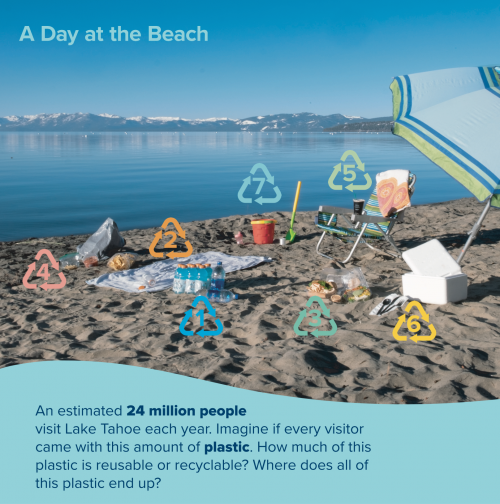
This project is a collaborative effort from TERC's researchers and educators. Microplastics are defined as any type of plastic fragment that is less than 5 mm in length. Plastics enter the natural environment from a variety of sources including cosmetics, clothing, and industrial processes. They break into smaller and smaller fragments by sunlight and physical abrasion from wind and waves, but never disappear. Research has shown microplastics entering the food chain, leaching chemicals, and showing up in soil and drinking water.
Extensive microplastics research has been conducted in marine research, however the research of its impacts on freshwater ecosystems is limited. TERC is working with the Desert Research Institute (DRI), Clean Up the Lake, the League to Save Lake Tahoe, Raley's stores, Sierra Watershed Education Partnerships, and Tahoe Water Suppliers Association, to lead the research and education efforts at Lake Tahoe in this emerging field.
For more information contact Heather Segale or Katie Senft.
Research
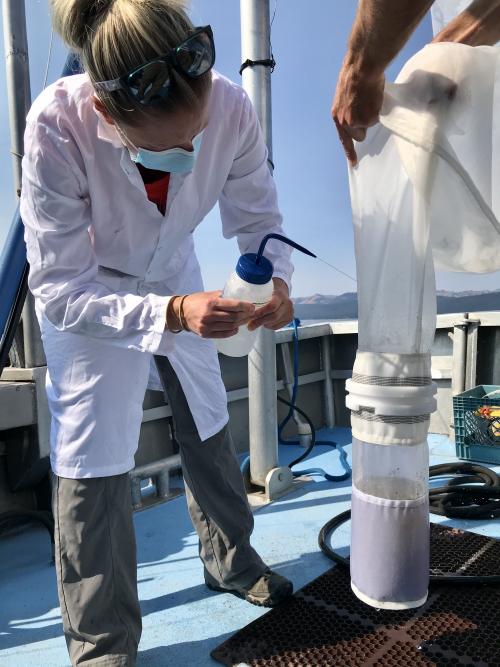
Scientists from TERC and DRI are collaborating to study the threat microplastics pose to the health of Lake Tahoe. The teams are studying different aspects of the problem. While TERC is researching the fate of microplastics to determine where they end up in the lake, DRI is studying the inputs—inflowing streams, accumulation on snow, storm drains, and even dryer vents.
In summer 2018 and 2019, field researcher Katie Senft led a pilot project through a summer internship program with TERC and found microplastics in many of the samples of beach sand collected. Building on that pilot project with funding from the Nevada Division of Environmental Protection (NDEP) and the U.S. Environmental Protection Agency (EPA), Senft’s team continues to investigate the fate of microplastics in Lake Tahoe.
The team began sampling for microplastics in summer 2020, performing regular trawls at various depths throughout the lake, and collecting deep-water sediment samples to capture heavier plastics. Researchers also sample municipal water treatment facilities and Kokanee salmon and Asian clam tissues to assess the impacts on filter-feeding biota. Sampling protocols build on previous studies to measure microplastics in the waters at every depth of the lake and other areas of the surrounding watershed. Samples aimed to confirm microscopic particles will be subject to Raman microspectroscopy by Dr. Jenessa Gjeltema, associate professor in zoological medicine at UC Davis. Gjeltema uses the technology to determine the types of microplastics found in very tiny pieces.
TERC’s science team takes a multidisciplinary approach. Only by looking at the watershed as a whole—with its trees, animals, roadways, and people—can we truly understand what’s happening to the lake. The plastic problem is similar. We cannot understand the ecological harms without exploring the human industries and big corporations that created the plastic problem in the first place.
Microplastics FAQ
Outreach
The TERC education team is continuing to work on a campaign to reduce reliance on single-use plastics in the Tahoe basin. This multifaceted project is funded by Nevada Division of Environmental Protection (NDEP) and includes an exhibit explaining the science of microplastics, various classroom programs, development of an outreach campaign as part of Take Care Tahoe (takecaretahoe.org), and a partnership with Raley's to sell reusable water bottles alongside educational signage.
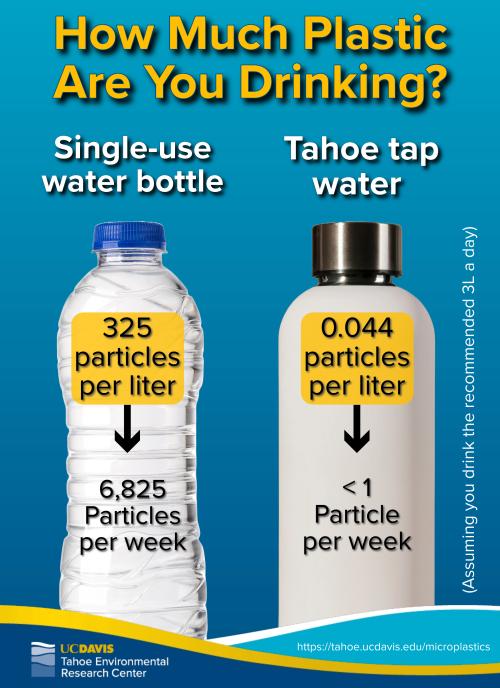
1. Gjeltema, J., Senft., K. Lang, J., Sesma, S. and Schladow, G. 2023. To Sink or Swim: A Snapshot Evaluation of the Fate and Types of Microplastics in Lake Tahoe. A Report to the Nevada Division of Environmental Protection.
2. Mason. S., Welch, V., and Neratko, J. 2018. Synthetic Polymer Contamination in Bottled Water. Frontiers Chem., Vol. 6.
https://www.frontiersin.org/articles/10.3389
3. https://www.healthline.com/nutrition/how-much-water-should-you-drink-per-day
Exhibit
In order to communicate TERC’s important microplastics research to the public, the education team has installed a new exhibit at the UC Davis Tahoe Science Center in Incline Village, Nevada. The exhibit, called “Tahoe’s Plastic Problem,” explores plastic pollution at Lake Tahoe through a series of wall panels and hands-on activities. Starting with “A Day at the Beach,” see a beach-goer with multiple single-use plastic products. Follow those plastic items as they break apart into smaller and smaller pieces, known as microplastics. Engage with hands-on activities to investigate different sizes of plastic and learn about their impacts on the environment. These science activities model the same methods used to conduct microplastics research by UC Davis TERC.
The exhibit wraps up with a call to action: it is not enough to change our habits of buying and disposing of single-use plastics, we must also stop the production of the non-essential, single-use plastics in the first place.
Education programs
Together with the Tahoe Water Suppliers Association (TWSA) and Sierra Watershed Education Partnership (SWEP), and the League to Save Lake Tahoe, the TERC education team has developed curricula to teach local students about the plastic problem and encourage them to become part of the solution.
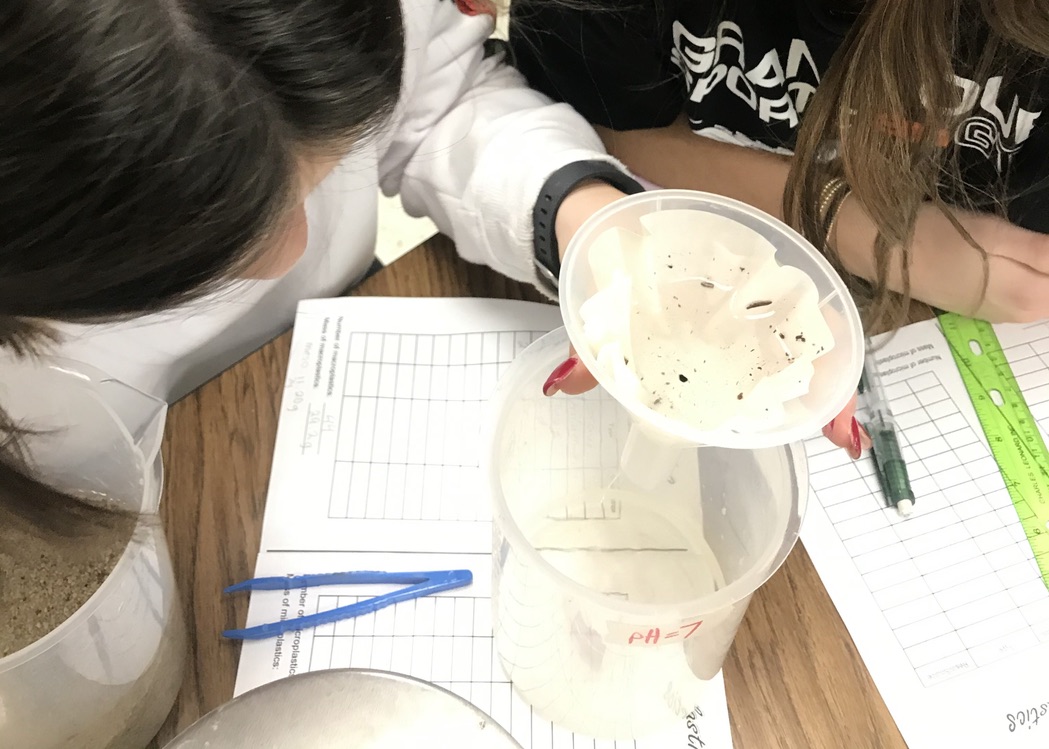
TERC educators have presented microplastics education to students at four local high schools, both in-person and virtually. Before the move to distance and hybrid learning in 2020, the education team developed a series of informative and hands-on classroom activities to get the high school students engaged in the local environmental problem of plastic litter.
The classroom activities allowed students to explore the recycling at their own high schools and to analyze microplastics collected from local beaches. This background knowledge allows students to prepare for a campaign to reduce the number of plastic products sold at local Raley’s grocery stores.
Reusable Water Bottles
Several Raley’s grocery stores the Tahoe area have partnered with TERC in order to print reusable metal water bottles that feature “Drink Tahoe Tap ®” and plastic-free messaging. Raley’s launched this campaign to encourage customers to make the more sustainable choice of going reusable in the single-use plastic water bottle aisle. Due to the success of this initial project, Raley has expanded the campaign to other stores in Truckee, CA and Reno, NV.
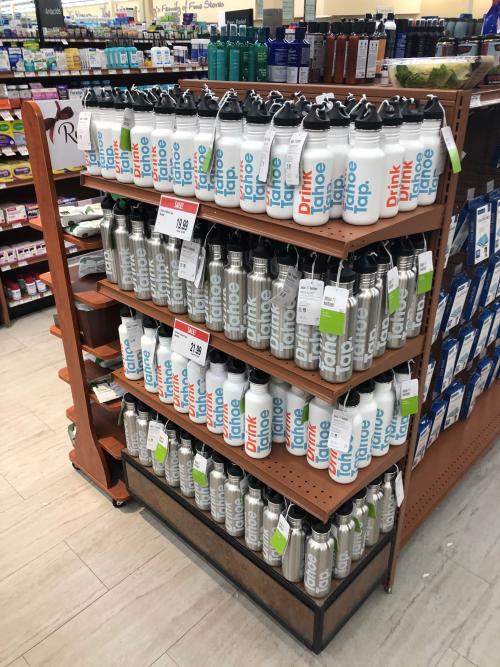
The components of the marketing campaign were designed to build on the highly visible and effective Take Care Tahoe campaign. By using eye-catching bright colors and witty phrases like “Break Up With Plastic,” “Water in Plastic Bottles is Trucked Up,” and “Fill Anywhere, Take Everywhere,” the water bottles will not only serve as a sustainable way to fill up on water, but will also encourage others to rethink their plastic use as well.
In conjunction with the sale of reusable water bottles, TERC also conducted a survey on single-use water bottle usage in the Tahoe area by residents and visitors. If you haven’t taken it already, the survey is available at https://www.tinyurl.com/TahoeWaterBottleSurvey.
The sale of these reusable water bottles will be coupled with a push to increase accessibility to drinking water filling stations around the basin. In partnership with several local high schools, TERC plans to double the number of refill stations on the mobile “Tap App,” which points folks toward locations where they can refill their water bottles. In 2021, groups of students from four local high schools presented ways to increase sustainability to the Raley’s executive team, successfully moving the needle on plastic pollution.
Tahoe's Plastic Problem Exhibit
The exhibit explores plastic pollution at Lake Tahoe through a series of wall panels and hands-on activities. The exhibit features a large five-panel wall display and three tables of hands-on activities aimed to engage visitors in both the science of plastics as well as the solutions to the current global plastic crisis.
The panels across the wall tell the story of “A Day at the Beach,” with a large photo of a Lake Tahoe scene laden with everyday, single-use plastics. The exhibit then follows those plastics as they break apart into tiny pieces and shows how they impact the food web and the ecosystem. The activity tables allow visitors to engage in hands-on activities, investigate different sizes of plastic, and learn about their impacts on the environment. These science activities model the same methods used to conduct microplastics research by UC Davis TERC.
The exhibit wraps up with a call to action. It is not enough to change our habits of buying and disposing of single-use plastics. We must also stop the production of non-essential, single-use plastics in the first place.

